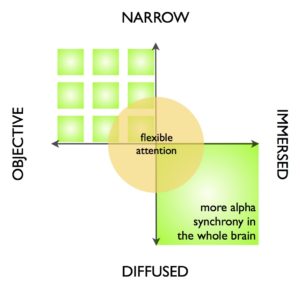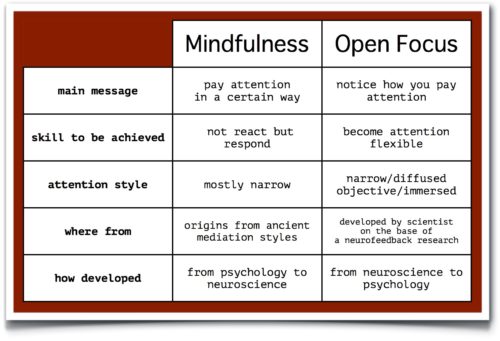

by Sarah Gulland, Collective Evolution
Mindfulness is defined as an attention training which can benefit health and general well-being. There is a lot scientific research confirming it. It usually takes weeks to practice Mindfulness before experiencing noticeable benefits. In this article I will present you the other type of attention training called Open Focus. I believe, combining these two approaches may help to understand attention training better and to experience its benefits faster.
What Is Mindfulness?
In its most basic form, Mindfulness means to pay attention to what’s happening, on purpose, in the present moment, and to do so without judgement. Originally from Buddhist roots, it was introduced into the West by Dr. Jon Kabat-Zin and the University of Massachusetts. Since its appearance in the West around twenty years ago, many people have participated in the Mindfulness based stress reduction course and similar programs. Research shows that participants may experience profound benefits such as reduced stress, a greater sense of well-being, increased clarity and focus, and improved sleeping patterns.
According to Dr. Kabat-Zin, by paying attention in a certain way, we can switch off our so-called autopilot mode, in which we often go through life unaware of what’s happening within and around us. Living on autopilot not only means that we miss out on a lot of the richness of life, but we are also more likely to be stressed. Stress and autopilot are linked because when we are on autopilot, we are much more likely to act out unhelpful or even damaging patterns of behaviour. In other words, we react instead of respond to challenging experiences in our life. Mindfulness helps us to become aware of these habitual patterns and gives us a choice to change how we relate to challenging experiences. It’s not about taking stress away or hoping to live a life without any stress, but rather fundamentally changing how we relate to the things we experience.
On the other hand, many of us spend much of our time living in our heads. We live in a kind of virtual reality consisting of thoughts and inner dialogue, and thoughts tend to relate either to the past or to the future. Mindfulness helps us to learn how to return to the present and to what’s actually happening rather than our perceptions of what’s happening, which are often inaccurate. We practice it by cultivating greater somatic awareness — that is, awareness of the body, because the body is always in the present moment.
Ultimately, the more we practice Mindfulness and observe the changing nature of experience, the more we may begin to sense that what we previously thought of as being tangible and solid, such as our sense of self, is actually quite transitory and ephemeral. We may begin to understand what lies beyond objects arising in awareness such as sensations, thoughts, and emotions. We may begin to experience awareness itself. This is an extremely significant moment in practice and in life, when we start to experience ourselves as something greater than what we observe and our sense of being the observer.
In Mindfulness, attention generaly focuses on one object (such as the breath, sensations in the body, thoughts, or emotions), exploring it with a sense of curiosity and interest. Another way Mindfulness can be practiced is through Open Monitoring or Open Awareness, where no particular object of experience is selected and there is an openness to all that is unfolding within awareness. Here too, however, as various objects pass through awareness, attention is often paid to each object in a narrowly focused wa
What Is Open Focus?
Open Focus is the name of an attention training program created by Dr. Lester Fehmi, a neuroscientist and psychologist from Princeton University. Dr. Fehmi found that once our whole brain activity becomes more synchronous in alpha frequency, our mental and physical health improves. He created a series of mind exercises that help to cultivate this brainwave pattern, and he designed a neurofeedback EEG machine that can detect it.
On the basis of his findings, Dr. Fehmi developed The Four Attention Styles theory, which describes four different ways we can pay attention, and relates these styles to brain physiology.
According to Dr Fehmi, pain, stress, anxiety, and other challenges make our attention narrow and objective. It is natural to narrow our attention (focus) on pain or a problem in order to deal with it efficiently, but most people overuse this style in everyday life. They are unaware that it keeps them in continuous ‘fight or flight’ mode (see this post). Moreover, habitual focusing creates an impression that the reality consists of separated objects, since we can focus on only one thing at a time, leaving the rest outside of our focus. It can make us feel distant, alienated, and lonely.
Dr. Fehmi says we can begin relating to what’s difficult in a more balanced, accepting way by diffusing our attention. Diffusing allows us to see the big picture and connect (immerse) with its elements. It helps to realign with the world and to create healthy relationships. This style is linked to the ‘rest and digest’ part of our physiology and makes the whole brain activity more synchronous in alpha frequency, which can be confirmed by Dr. Fehmi’s machine (see graph below).
Dr. Fehmi suggests everyone’s attention should be flexible, meaning that you can alternate between ‘narrow and objective’ and ‘diffused and immersed’ styles of attention or balance all at the same time. Dr. Fehmi says that the way we pay attention is directly linked to our well-being. Once you are able to balance your attention, you can positively influence your mind and body.
During Open Focus training, we practice diffusing by becoming simultaneously aware of many objects. The object can be everything you can focus on, like a physical object, a sound, a taste, a thought, a feeling, a sensation from the body, etc. Then you can progress to awareness of the space between objects, like the space between physical objects, the silence between sounds, or the breaks between thoughts, etc. Finally, you become aware of space between and inside objects which, according to Dr. Fehmi, helps us achieve diffused and immersed style. In this style of attending, all objects (including yourself) dissolve in space and you immerse with reality, becoming fully connected.
Are Mindfulness and Open Focus Complementary?
Open Focus and Mindfulness are not distinct and competing practices but rather highly complementary.
Mindfulness helps us to learn to pay attention to our experience and to notice how we are relating to it. Open Focus then builds upon the benefits and skills of Mindfulness by training us not just to pay attention, but to be more aware of how we are paying attention and to be more flexible in our attention styles.
We then have the benefits of two complementary practices available to us: learning to pay attention and being flexible in how we pay attention. We could say that Mindfulness is an excellent foundation for Open Focus training and that Open Focus helps us to get the most from Mindfulness training.
What Can Open Focus Offer Mindfulness?
As mentioned, much Mindfulness practice is based on a narrow way of paying attention (that is, we are focused on one object). Although it is useful in helping us to be more aware of what is happening in the moment, overusing this style may lead to tightness and overexertion in unexperienced practitioners, since many people think they have a choice of staying watchful (mindful) of what is happening, or they slip into daydreaming. They keep trying harder and it makes them exhausted and it sometimes leads to frustration and disappointment.
We therefore propose that Open Focus can bring to Mindfulness the idea of paying attention in the diffused style and the concept of attention flexibility.
Mindfulness practitioners who learn how to diffuse their attention may find that it helps them to progress. There are several reason for this.
The diffused attention style tends to quickly quiet internal chatter. For example, it is sometimes enough to become aware of sensations coming from both hands and at the same time to sense peace and calmness of the mind. It is because synchronous alpha brain waves play a top-down inhibitory role in the brain network. The quiet mind makes observing without judgment much easier.
In diffused attention style, you do not redirect your attention from one object to another, but rather redistribute it between many objects, which are attended at the same time. The only way to do it is to attend objects in a very soft (less rigid, relaxed) way. This skill can then be used in everyday life. For example, you can stay continuously aware of breathing while listening to someone talking to you and there is no struggle between competing objects in your awareness. It helps to continuously sense the present moment and it has very practical applications (see this post).
It is important to note that in this style, one of the objects you pay attention to could be your daydreaming. Including daydreaming into the diffused attention helps to reduce struggle with it during practice. It is possible (and quite easy) to accept daydreaming as one of many objects you pay attention to (see this post). It can be easily extended to everyday life and it helps to stay present.
In order to become fully aware of the world, it can be helpful to cultivate a more diffused than focused attention style. Focused attention requires one to cut off a lot of what is really happening around us and it restricts experience to a narrow stream of sensations. In the diffused attention style, you are aware of the object and its background (see this post). This may broaden the perspective, helping to put things into context. It may also help to disable an autopilot and develop one’s ability to respond as opposite to reacting.
As mentioned previously, Open Focus exercises cultivate an awareness of space around and inside objects. Once a practitioner is aware of space inside the object, it may become softer, lighter, and easier to be with and observe (for example when we attend an unwanted emotion). By switching to a diffused attention style, the difficulty may be diluted by a broader spectrum of attention. This could be likened to putting a teaspoon of salt in an egg cup filled with water and tasting it — the water would taste very salty. If the same teaspoon of salt were put in a swimming pool, it would be difficult to taste the salt. Mindfulness enables us to be aware that there is salt in the water, but Open Focus allows us to experience the salt in the context of the swimming pool rather than the egg cup!
The diffused and immersed attention style helps to dissolve objects like pain or unwanted feelings. Mindfulness practitioners are sometimes encouraged to bring attention to an ache in the back and to observe how this ache feels, exploring how it would be to allow the ache to be there. In Open Focus, they might feel the ache but at the same time feel the space around and in the ache together with the space in the room. In addition, they might imagine that we are part of the ache itself, allowing themselves to become immersed in the ache. This sometimes makes the pain or feeling softer, blurred with its background, and then it may naturally and effortlessly dissolve. The dissolving pain and unwanted feelings process is well documented in Dr Fehmi’s book.
Conclusion
Mindfulness teaches us to pay attention to our experiences so that we can interrupt habitual patterns of relating to ourselves and the world that may not be helpful for us. Open Focus enhances Mindfulness practice by teaching us not just to pay attention, but to bring more awareness to how we are paying attention.
As this article has demonstrated, these are two highly complementary and mutually reinforcing practices. Ultimately, with both we can learn to be present and be flexible in how we are present, after which we may uncover an unlimited sense of peace and love that lies beneath the ‘noise’ that we are usually confronted with and try to suppress.
In scientific terms, this may be regarded as homeostasis; in more spiritual language, this may be regarded as revealing our true nature or higher self. These practices may lead us to fulfil our personal and evolutionary potential and to live lives with grace and ease.
How You Can Try Mindfulness and Open Focus
We could write a lot but more about Mindfulness and Open Focus, but the best way to know them is to feel them!
You can try some good Mindfulness exercises here: Breathing Into Being, Taking In The Good, Self Compassion.
There is a choice of Open Focus exercises on Dr Fehmi’s and Tomasz’s website (the main difference is that most of Tomasz’s exercises are shorter and they are designed to introduce diffusing and to bring a quick and noticeable experience).
This article was written with Mrs. Sarah Gulland a Mindfulness teacher who works from London, Guildford and Sussex.




Comments
I can't wait to read more
I can't wait to read more about it. It sounds as if we're giving a Western's interpretation of Dzogchen, or Mahamudra. This is great stuff. Keep 'em coming!
As Above, So Below
As Below, So Above